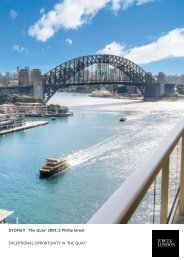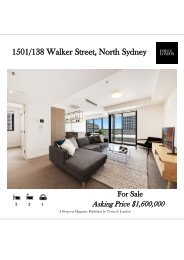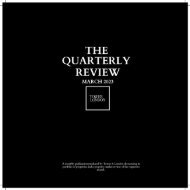2008 Spring
You also want an ePaper? Increase the reach of your titles
YUMPU automatically turns print PDFs into web optimized ePapers that Google loves.
The ingredients for rent rises are all there:<br />
• Investors are not buying, therefore<br />
developers are not building. Bingo!<br />
Investors are a key ingredient.<br />
Developers rely on investors more than<br />
owner occupiers. Many properties are<br />
sold as investments off the plan and a<br />
good percentage of these transactions<br />
take place even before construction<br />
finance is approved. When investment<br />
is down, properties are sold to owner<br />
occupiers and this reduces the share<br />
of accommodation available for rent.<br />
• Generation Y put a lot of pressure on<br />
the rental market: renting is not an intrinsic<br />
part of this demographic, in fact, if given the<br />
chance and affordability space, Gen Y would<br />
flock to the market, using the Internet to<br />
source important property information. But,<br />
resultant from the deficiency of adequate, well<br />
placed and affordable property, Australia’s<br />
young adults are choosing to rent homes that<br />
are near where they need or want to spend<br />
their time. This in turn directly affects vacancy<br />
rates and rent prices.<br />
• Australia’s Population increase also<br />
affects supply and demand: the number of<br />
people leaving Australian shores is not<br />
enough to level out the demand for<br />
accommodation placed on the rental market<br />
because of a growing population with limited<br />
supply.<br />
• Building approvals are down because<br />
Governments impose many restrictions<br />
and taxes on the developers: The NSW<br />
government in particular imposes heavy<br />
taxes on property developers. Real<br />
Estate Institute of New South Wales<br />
(REINSW) President Steve Martin<br />
believes pressures could be eased if tax<br />
relief and other incentives are offered.<br />
It must also be noted that governments<br />
have always imposed taxes of varying<br />
degrees, so why does it matter now and not<br />
between 2002 and 2004 when apartment<br />
buildings were mushrooming everywhere?<br />
Building approvals are slipping, but the<br />
affects of these should not be affecting<br />
current rent levels. The drop in last June’s<br />
figures will not be felt for another 18 months<br />
to two years, when the buildings are<br />
completed.<br />
The question then is: why are<br />
investors not buying, even<br />
though rents are high and<br />
o c c u p a t i o n i s v i r t u a l l y<br />
guaranteed? Rate of return on an<br />
investment apartment is currently at<br />
5.1%, much higher than when the<br />
market was running hot in 2003. It is<br />
the value of a property, together<br />
with the interest rates, that makes<br />
residential property unattractive to invertors.<br />
Unfortunately, in Australia there are<br />
investors who fuel the property market when<br />
things are looking up and then desert the<br />
market when sentient is not favourable. It is<br />
my opinion that one of two things must<br />
happen so that investors return to the market.<br />
First, interest rates must come down so<br />
that the real cost of owning an investment<br />
property becomes less of a burden. This is<br />
most likely, given the latest economic<br />
indicators. Or, alternatively, property values<br />
must come down, as the continuation of rising<br />
rents can only last as long as tenants can<br />
afford it and most tenants have almost<br />
reached this peak.<br />
More should be done to attract middle<br />
level investors to the residential property<br />
market. Small family superannuation funds<br />
should be encouraged to participate and then,<br />
when more cashed up investors<br />
begin to partake, interest rate levels<br />
will cease to be as significant.<br />
Interest rates are only one factor in<br />
the purchasing decisions made by<br />
investors. The others are property<br />
values, rental return, building<br />
expenses, capital gains and long term<br />
viability of the locality. These factors, in<br />
conjunction with the other economic and<br />
societal conditions in Australia, affect the<br />
Australian rental market.<br />
Page 6


















